Every now and then I am lucky enough to write a review on a product which I
feel has met or exceeded my expectations on every level. These are
generally what I consider timeless products, in that they are not an item
which can be (or will be) easily updated or outdated anytime soon. The
Lumaray
FL6 LED Flashlight was just such a device. Other than the fact that the
shaft did not have a non-slip texture, I felt that the torch got everything
right. If the Gadgeteer was a site that gave numeric ratings on products, I
would have called the FL6 LED Flashlight a 9 out of 10.
In my enthusiasm for the product, I showed the FL6 to a good friend of mine
that is a Tom Green County Sheriff’s Department Detective. I could tell by the
way he kept complimenting the flashlight and offering to "test it out" during
their night exercises that he was trying to finagle it from me. I finally let
him, only because he is such a good friend, but I admit that in the back
of my mind I regretted it. Selfish Judie rears her ugly head…
Not long ago, I received an email from Ed, a technical consultant with
Lumaray, telling me about their newest model flashlight. I wasn’t sure what to
expect, I mean – how do you improve upon perfection? I was figuring that the new
torch would be a totally different design, and all of the features that I liked
so much about the FL6 would be replaced by some new design that I would either
love, or that would make me nostalgic for the old.
But I needn’t have worried, as Ed sent me a newly designed head that fit onto
the original Lumaray’s body. That’s when I had to tell him that I no longer had
the original flashlight they had sent, that I had given it to my friend. He was
kind enough to send me an additional flashlight body, which when coupled with
the new head created the
FL12 LED
Flashlight… basically an FL6 on steroids.
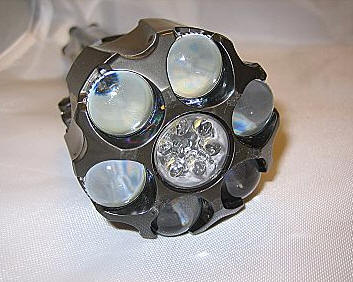
Because the FL12 does use the same body as the original FL6, the new material
in this review will concern the head of the flashlight and it’s performance. I
will be essentially reprinting the information concerning the flashlight’s body,
so for those that are already familiar with my previous review, those portions
will be a trip down memory lane.
The Fl12 is available in Gunmetal Hero, which I previously described as a
gunmetal gray colored plastic with olive colored aluminum ball-joints and a
large stainless steel contact spring.
Specifications:
| Size: | 8.3" x 2.25" |
| Weight: | 5.4oz without / 12.8oz with batteries |
| Battery Type: | 3 "C" cell (not included) |
| Continuous Run-Time: | ~400 hours, ~8 hours at high brightness |
| Brightness: | ~720,000 mcd/~1060 Lux at beam center |
| LED: | 12 Nichia 5mm (white) |
| Beam Type: | Combination (Spot with Flood) |
| Switch Type: | Twist bezel ON/OFF |
| Water Proof: | Submersible up to 15′ |
| Box Contents: | FL12 Flashlight, Instructions Manual |
| Warranty: | 1 yr Limited Warranty |
Those familiar with the FL6 will immediately notice that the big change here
is the addition of six bright white Nichia LEDs in the FL12’s center in what was
an empty area that simply showed the Lumaray branding on the FL6 model.
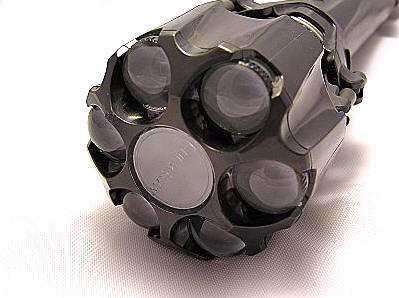
The FL6 head with the non-illuminated center
There are of course some performance differences between the two models.
Because of the addition of six more LEDs, the brightness of the FL12 has been
raised to ~720,000 mcd (~1060Lux at beam center) vs. the FL6’s ~352,000 mcd
(~470Lux at beam center). As would be expected, battery life has taken a hit
however. The FL12 site says that about 8 hours can now be expected when the
light is on full brightness, vs. the FL6’s 10-15 hours. I am not too sure about
Lumaray’s run-time figures though, as the FL12 is shown at about 400 vs. the FL6
at about 200.
As did the FL6, the FL12 boasts and anti-roll head which can support the
torch when it is upright.
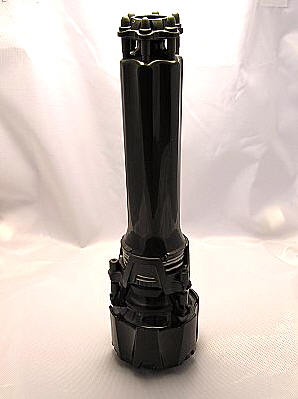
The deep bevels of the LED head unit keep the torch from rolling when it is
placed a flat surface, and on an uneven surface the light will have a better
chance of not falling.
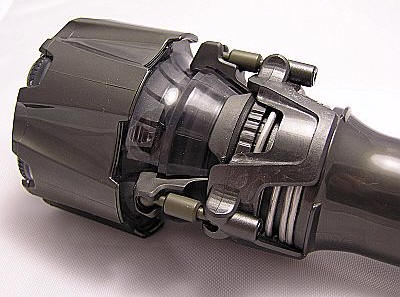
Other than its head, the most distinctive part of the FL12’s design are the
three cantilever mechanism and ball joint connections positioned at the base of
the torch head which together make up the trigger unit. Without reading the
instructions, loading the batteries for the first time will be tricky – trust
me.
Here’s how you do it:
1. Rotate the entire trigger unit so that the "quick release trigger pad" is
no longer sitting on top of a ledge stop.
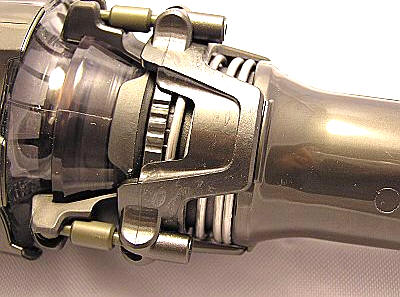
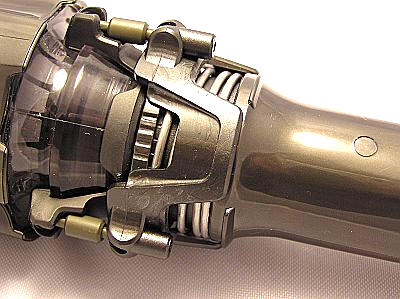
2. Now that the trigger unit is no longer locked, the thumb is placed on one
pad and the forefinger on either remaining pad.
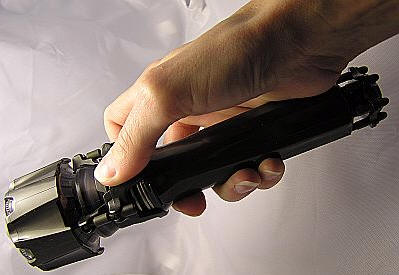
Using the remaining three fingers of that hand to balance and hold the shaft
of the light as you pull down on the pads with your thumb and finger. These
trigger pads have a short rough edge that works, but ideally I would like the
trigger pads to be a bit more textured as a greasy or wet finger makes for a
tougher opening.

Until you get proficient at one handed operation, you can butt the end of the
FL12 against something to help stabilize it, as you do the downward motion. Or
you can always use your second hand, a leg, or any flat surface.
Viola, the cantilever system will work, pulling back the ball joint
connections and releasing the LED head unit.
Once the head unit has been removed, the battery compartment is revealed.
Three rubber O-Rings adorn the top of the shaft, with cutouts strategically
placed under the the last O-Ring so that it can slow the batteries down as they
are dumped from the tube. Designed so that the batteries will not come tumbling
out too quickly, they are instead released in a manner which makes them much
easier to catch and less likely to fall. This is probably a good time for me to
mention that the batteries should last for 10 – 15 hours of high brightness. For
those that prefer a rechargeable flashlight, it would be necessary to invest in
some rechargeable "C" cells. However, it is good to know that any "C" cell will
work in a pinch.

The head unit can be replaced by simply pushing it back in position. The
levers will retract and slide over the base of the unit, once again securely
catching on its ledge.
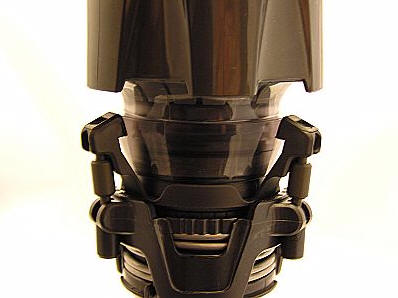

Even though the major parts are made of plastic, everything feels quite
solid; there is no creaking and at no time did I get the feeling that I might
break something if I twisted things the wrong way. The shaft of the Lumaray is
smooth at the top, and then it bevels towards the base. I would still like a
more textured feel in the grip area, although the shaft is not overly slippery.
The base of the Lumaray continues the futuristic design, but the six olive
colored aluminum pins do more than just look good – they offer a place where a
lanyard can be attached without sacrificing the FL12’s ability to stand on it’s
bottom end and be used as a lantern in a dark room.
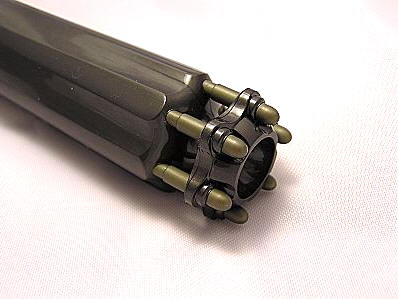

So there’s the exterior, which as promised was basically taken from my
Lumaray FL6 review.
Now, we can take a look at the differences between the FL6 and the FL12. In
the tradition of the classic Mag-Light, a 180º
turn to the left switches on the twelve incredibly bright
Nichia LEDs, which are rated for 100,000
hours and are not user replaceable.

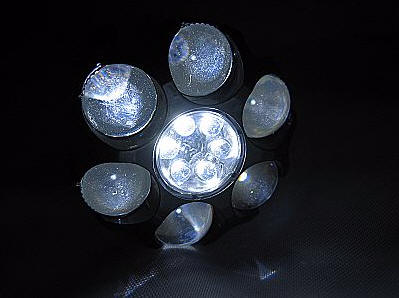
From left to right: the FL6 and the FL12 when powered on
The interior of the head unit is covered with some sort of glow-in-the dark
coating, so that every time the power is switched on, the coating is recharged.
On the FL6, this results in a soft greenish blue glow which makes the light easy
to find in the darkness. On the FL12, the glow-coating seems to be a more true
green. This glow will last for several hours, and it will be recharged anytime
the light is used.

From left to right: FL6 and then FL12
Because of the rubber O-Rings in the Lumaray’s bezel, it is waterproof and
submersible to 15 feet. However, the flashlight will not float, so if the user
is caught in a flash flood or something, a wrist strap would be very handy.
I was able to take my flashlight shots down a pitch black hallway last night,
and I used a different camera than when I did the FL6 review. This camera does
not try to overcompensate in a darkened situation, so I retook the FL6’s in
order that the comparison photos would be shot in an equal situation. As before,
the light from the FL6’s six LEDs was incredibly bright, with no fading
even at the far end of my hallway. But as you can see by the photo on the right,
the FL12’s twelve LEDs were significantly brighter. In each case, the
clustered lights aimed to provide a single solid round beam.
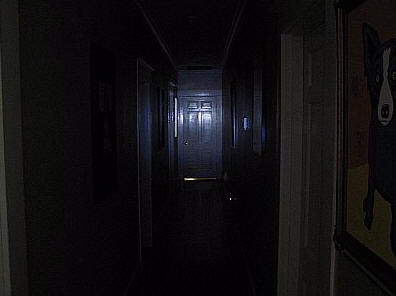

From left to right: The FL6’s beam and the FL12’s beam cast
from 37 feet away down a pitch black hallway
I am pleased to report that the Lumaray FL12 stayed completely true to the
futuristic styling of the FL6, and it manages to improve upon what was already a
near flawless flashlight. I would of course still like to see the Lumaray line
offered in other finishes, such as brushed metal or in a rubber coated metal,
but that’s just me voicing my opinion. The current Xenoy body is certainly tough
enough. Depending on your needs, the FL6 may be bright enough, but if you want
that extra oomph that six additional bright white LED Nichia lights can provide,
then the Lumaray FL12 may be the torch you have been waiting for.
Price: $119.95
Pros:
Rugged futuristic design
One handed battery removal and replacement
Waterproof and submergible to 15 feet
Incredibly bright twelve LED cluster head design
Cons:
No rubber or texture on shaft to promote non-slip grip
INIU Mini Portable Charger, Small 45W PD Power Bank, 10000mAh USB C in&Out Fast Charging Pocket Size Battery Pack, Travel Essentials Powerbank for iPhone 17 16 15 14 Pro Air, Xiaomi, Samsung S24 etc
32% OffINIU Portable Charger, Smallest 22.5W 10000mAh Power Bank, USB C in/Output Fast Charging 3-Output Mini Battery Pack Charger with Phone Holder for iPhone 17 16 15 14 Air Samsung S23 Google iPad Tablet
19% OffProduct Information
| Price: | 119.95 |
| Pros: |
|
| Cons: |
|



